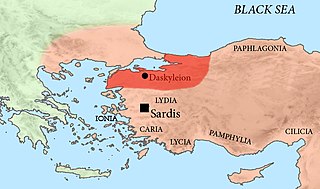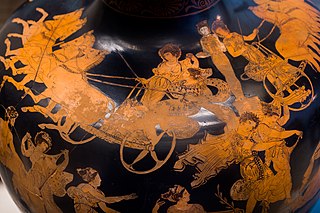
The Seven Sages or Seven Wise Men was the title given to seven philosophers, statesmen, and law-givers of the 7–6th century BCE who were renowned for their wisdom.

Miletus was an ancient Greek city on the western coast of Anatolia, near the mouth of the Maeander River in ancient Ionia. Its ruins are located near the modern village of Balat in Aydın Province, Turkey. Before the Persian rule that started in the 6th century BC, Miletus was considered among the greatest and wealthiest of Greek cities.
Apollodorus was a popular name in ancient Greece. It is the masculine gender of a noun compounded from Apollo, the deity, and doron, "gift"; that is, "Gift of Apollo." It may refer to:
Diogenes was a Greek philosopher and one of the founders of Cynic philosophy.
Olympiodoros or Olympiodorus can refer to:
Musaeus, Musaios or Musäus may refer to:

Ariobarzanes, sometimes known as Ariobarzanes I of Cius, was a Persian Satrap of Phrygia and military commander, leader of an independence revolt, and the first known of the line of rulers of the Greek town of Cius who eventually were to stem the kings of Pontus in the 3rd century BCE. Ariobarzanes was apparently a cadet member of the Achaemenid dynasty, possibly son of Pharnabazus II, and part of the Pharnacid dynasty which had settled to hold Dascylium of Hellespont in the 470s BCE. Cius is located near Dascylium, and Cius seemingly was a share of family holdings for the branch of Ariobarzanes.
The name Clearchus or Clearch may refer to:

The Meidias Painter was an Athenian red-figure vase painter in Ancient Greece, active in the last quarter of the 5th century BCE. He is named after the potter whose signature is found on a large hydria of the Meidias Painter’s decoration, excavated from an Etruscan tomb. Eduard Gerhard first identified this inscription in 1839, and it was he who determined the scene on the vase was the rape of the daughters of Leukippos where previously it was thought to be the race of Hippomenes and Atalanta.

The following outline is provided as an overview of and topical guide to ancient Greece:
Lamponeia or Lamponia (Λαμπωνία), also known as Lamponium or Lamponion (Λαμπώνιον), was an Aeolian city on the southern coast of the Troad region of Anatolia. Its archaeological remains have been located above the village of Kozlu in the district of Ayvacık in Çanakkale Province in Turkey. The site was first visited by Platon de Tchiatcheff in 1849, and later surveyed and identified as Lamponeia by Joseph Thacher Clarke, the excavator of nearby Assos, in 1882, and by Walther Judeich in 1896.

The Asclepieion of Athens was the sanctuary built in honour of the gods Asclepius and Hygieia, located west of the Theatre of Dionysos and east of the Pelargikon wall on the southern escarpment of the Acropolis hill. It was one of several asklepieia in the ancient Greek world that served as rudimentary hospitals. It was founded in the year 419–18 BCE during the Peloponnesian War, perhaps as a direct result of the plague, by Telemachos Acharneas. His foundation is inscribed in the Telemachos Monument, a double-sided, marble column which is topped by reliefs depicting the arrival of the god in Athens from Epidaurus and his reception by Telemachos. The sanctuary complex consisted of the temple and the altar of the god as well as two galleries, the Doric stoa which served as a katagogion for overnight patients in the Asklepieion and their miraculous healing by the god, and the Ionic Stoa that served as a dining hall and lodging for the priests of Asclepius and their visitors.
This page is based on this
Wikipedia article Text is available under the
CC BY-SA 4.0 license; additional terms may apply.
Images, videos and audio are available under their respective licenses.






